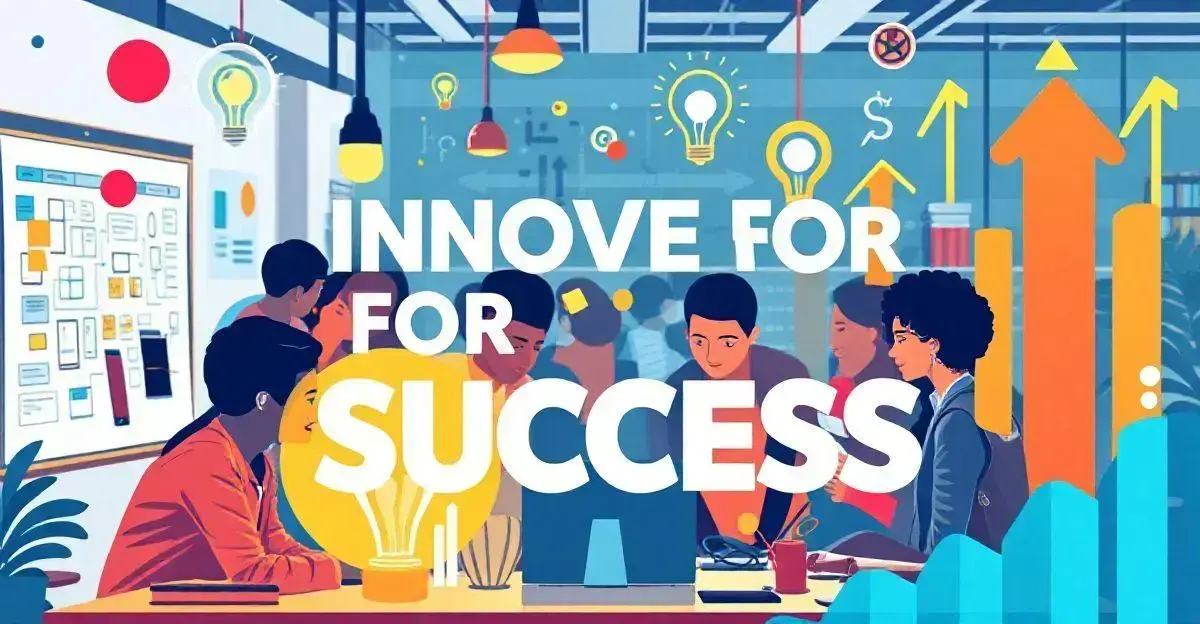Innovate for success is essential in today’s fast-paced world. Embracing innovation not only drives growth but also fosters a vibrant culture within your team.
Understanding Innovation and Success
Understanding innovation and success is crucial for any business aiming to thrive in today’s dynamic environment. Innovation extends beyond technology; it involves improving processes, services, and products. To innovate successfully, businesses must cultivate a creative culture that encourages collaboration and experimentation.
Success stems from identifying problems and crafting innovative solutions that resonate with customers. By adopting a proactive approach, companies can stay ahead of trends and meet the changing needs of their audiences. Listening to customer feedback and analyzing market trends are essential steps in this journey.
Effective leadership also plays a vital role in promoting innovation. Leaders should inspire teams to think outside the box and embrace new ideas. By fostering an open environment, employees feel empowered to share insights that could lead to groundbreaking advancements.
Embracing innovation is a pathway to success. Businesses that adapt and innovate can navigate challenges and seize opportunities, ultimately positioning themselves for long-term growth.
The Importance of a Growth Mindset

The importance of a growth mindset cannot be overstated in the journey of innovation. This perspective fosters a love for learning and resilience, which are essential for achieving great things.
Having a growth mindset allows individuals and organizations to embrace challenges, persist through obstacles, and view failures as opportunities for growth. When faced with challenges, it encourages teams to focus on solutions rather than dwelling on the problem itself, leading to continuous improvement and innovation.
Furthermore, a growth mindset promotes collaboration. When team members feel safe to share ideas and take risks, creativity flourishes. By creating an atmosphere where everyone contributes, organizations can leverage diverse perspectives for better outcomes.
Ultimately, nurturing a growth mindset is vital for any business looking to innovate for success. It builds a workforce that is not only capable of adapting to change but also eager to contribute to it.
Practical Steps to Innovate
Practical Steps to Innovate include several key strategies that businesses can implement to foster a culture of innovation. First, conducting regular brainstorming sessions allows team members to share ideas openly. It’s important that these sessions are non-judgmental to encourage creativity.
Secondly, businesses should focus on customer feedback. Listening to what customers want helps guide the innovation process. Surveys, reviews, and direct communication can provide valuable insights into areas for improvement or new products.
Another step is to invest in training and development. Providing team members with skills and knowledge related to innovation can empower them to contribute effectively. Workshops that focus on creative problem-solving can be particularly beneficial.
Additionally, companies can establish partnerships with other businesses or organizations. Collaborating with external experts can provide fresh perspectives and help drive innovation.
Moreover, it’s essential to allocate resources specifically for innovation projects. Whether it’s time, budget, or personnel, having dedicated resources shows a commitment to innovation and encourages teams to pursue new ideas without fear of failing.
Finally, measuring the outcomes of innovation initiatives helps track progress and success. By analysing results, businesses can learn what works and what doesn’t, allowing them to refine their approach going forward.
Real-Life Success Stories

Real-Life Success Stories serve as powerful examples of how innovation leads to success. One notable case is that of Apple Inc., which transformed the technology landscape with the introduction of the iPhone. By combining cutting-edge design with user-friendly functionality, Apple reshaped how people communicate and interact with technology.
Another example is Netflix. Initially a DVD rental service, Netflix recognised the shift towards streaming. By investing in technology and original content, they have become a leader in the entertainment industry. Their ability to adapt quickly has allowed them to maintain a competitive edge.
Small businesses can also find inspiration in real-life stories. A local bakery, Sweet Treats, faced stiff competition but chose to innovate by introducing an online ordering system and unique flavour combinations that appealed to customers. Their innovative approach increased sales and expanded their customer base.
These examples show that success can often come from embracing change, being willing to experiment, and continuously looking for ways to improve. Each story highlights the importance of staying agile in a fast-evolving marketplace.
Overcoming Challenges to Innovation
Overcoming Challenges to Innovation is crucial for businesses aiming to stay competitive. Many organisations face resistance to change from employees who may be hesitant to adopt new processes. To address this, it is important to communicate the benefits of innovation clearly and involve team members in the decision-making process. Providing training can also help ease transitions.
Another challenge is limited resources, which can hinder innovation efforts. Companies should prioritise projects that align with their goals and allocate resources effectively. Fostering a culture of experimentation can enable teams to test ideas without large investments upfront.
Market competition is also a significant hurdle. Businesses must stay informed about industry trends and competitor strategies to adapt and innovate continuously. Conducting regular market research can help identify opportunities and potential threats, allowing organisations to be proactive rather than reactive.
Moreover, managing risks associated with innovation is vital. To mitigate risks, businesses can implement pilot programmes, testing new ideas on a smaller scale before a full launch. This method allows for learning and adjustments to improve the final product.
By acknowledging and addressing these challenges, businesses can create an environment where innovation thrives. Embracing change and overcoming obstacles will ultimately lead to greater success and growth.
Tools and Resources for Innovators

Tools and Resources for Innovators are essential for driving innovation in any organisation. First, brainstorming tools like MindMeister or Miro can help teams visualise and organise ideas effectively. These tools promote collaboration and allow everyone to contribute their thoughts.
Secondly, project management software such as Trello or Asana can streamline workflows and keep innovation projects on track. By assigning tasks and deadlines, teams can ensure that ideas progress through various stages of development.
Access to online resources is also important. Websites like TED Talks or Coursera offer valuable insights and courses on innovative thinking and strategies. These platforms enable individuals to learn from experts and apply new knowledge directly to their work.
Networking platforms, like LinkedIn, allow innovators to connect with industry leaders and peers. Sharing experiences and insights can lead to new collaborations and partnerships, enhancing the innovation process.
Lastly, consider investing in prototyping tools such as Sketch or Figma, which are great for visualising products and solutions before full-scale development. They enable teams to test and iterate ideas rapidly.
These tools and resources help create an enriching environment that fosters creativity and enhances the chances of innovative success.
Building an Innovative Company Culture
Building an Innovative Company Culture is essential for fostering creativity and growth. A positive culture encourages employees to share ideas and embrace risk-taking.
First, leadership commitment is crucial; leaders should model innovative behaviours and promote open communication.
Secondly, diversity and inclusion within teams can spark creativity. Diverse backgrounds and perspectives lead to unique ideas and solutions. It’s important to actively seek different voices in the innovation process.
Another vital aspect is providing time for exploration. Allocating hours for employees to work on personal projects or brainstorm new ideas can lead to unexpected breakthroughs. Companies like Google have successfully implemented ‘20% time’ policies.
Furthermore, recognising and rewarding innovative efforts is key. Celebrating both successful and failed attempts fosters an environment where employees feel safe to experiment. Regular workshops and innovation challenges can also engage teams and boost their creative thinking.
Lastly, creating spaces that encourage collaboration can enhance creativity. Open office layouts or dedicated innovation labs allow teams to interact more freely and share ideas fluidly.
Measuring Success in Innovation

Measuring success in innovation is vital for understanding the impact of your efforts. First, it is important to establish clear goals before starting any innovation project.
These goals should be specific, measurable, achievable, relevant, and time-bound (SMART). This framework helps keep the team focused and aligned on desired outcomes. Innovate for success by ensuring everyone understands these goals from the outset.
Next, implementing key performance indicators (KPIs) is essential. KPIs can include metrics such as customer adoption rates, revenue growth, or user satisfaction levels. Tracking these indicators provides insight into how well the innovation is performing in real time. Innovate for success by using data to guide your decisions and refine your approach.
Additionally, conducting regular feedback sessions with team members and customers can help gauge success. Gathering input on what works and what doesn’t allows for adjustments throughout the process. It also helps identify areas for further improvement.
Moreover, comparing outcomes against industry benchmarks can provide context for your results. This comparison helps to identify if the innovation is on par with or exceeding norms within the sector.
Finally, it’s important to accept that not every project will yield positive results. Embracing failures as learning opportunities contributes to a culture of innovation. By analysing what did not work, businesses can better inform their future strategies.
Cultivating a culture of innovation for sustainable success
Innovating for success requires a commitment to fostering a culture that embraces change. By implementing strategies to encourage ideas, companies can overcome challenges and leverage opportunities in today’s dynamic environment.
Success is not merely about the results; it is about learning from failures and continuously improving processes. Every step taken toward innovation contributes to long-term growth and adaptability.
As businesses navigate their path, it is essential to measure outcomes and celebrate achievements. This not only motivates teams but also highlights the impact of innovation efforts.
Ultimately, the journey of innovation is ongoing. Leaders must stay vigilant, inspire their teams, and remain open to new ideas to maintain their competitive edge.
